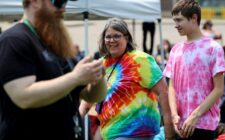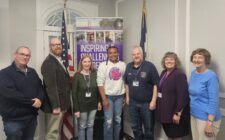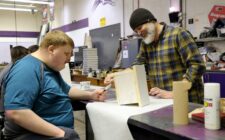What do a pigeon, a rat, and clover have in common?
They’re all being used to teach students in Nathaniel Roozeboom-Hemming’s Biology classes about the effects of urbanization on native species at a genetic level.
City pigeons tend to be darker in color because they have higher levels of melanin, which binds with heavy metals, thus preventing the heavy metals found in urban areas from binding with the actual pigeon itself and allowing the birds to survive long enough to pass on their genes.
Rats have been spotted in urban areas hauling whole pieces of pizza along public walkways, presumably to eat. Rural rats are unable to digest that much cheese, but, much like with their flying counterparts and melanin, urban rodents are able to digest more foods because their ancestors passed along genes that allow them to do so.
And rural clover produces higher levels of hydrogen cyanide than does urban clover because it discourages predators, and there are more clover predators in rural areas than urban ones.
“In essence, what we’re doing here is we’re teaching natural selection without just saying natural selection,” Roozeboom-Hemming said.
And thus is the premise of OpenSciEd, a science curriculum that the Burlington Community School District has been field testing for more than six years, first with sixth through eighth grade.
OpenSciEd is in its second year of use at the high school and will be rolled out at the fifth grade level in the coming fall.
Teachers who pilot the curriculum at each level provide feedback to the curriculum developers, who in turn use that feedback to adjust the relatively new material.
“The thing to understand about OpenSciEd and how it works is there’s a really particular order to the way that students learn,” Roozeboom-Hemming said. “So it starts with the anchoring phenomena, which is this big anchoring idea that sort of anchors students down to all the learning that they’re doing through the entire unit.”
The curriculum involves less direct instruction and more critical thinking on the part of the students.
“If you’re going for we’ve got to have a bunch of kids who know lots of general things, direct instruction is fine. It does its task of getting people to know basic things,” Roozeboom-Hemming said. “If you want to dig deeper, you have to start, as a teacher, stepping away and letting the students do the work themselves and struggle through it. Those deeper levels of understanding come from that struggle.”
There are also plenty of hands-on and modeling activities with sometimes intentionally vague instruction.
“It’s very purposeful sense-making, where they’re purposefully confused for a little while, because that feeling of confusion, as soon as you resolve it, things stick better,” Roozeboom-Hemming said. “It’s building the struggle and then resolving the struggle makes those ideas stick better. It’s confusing, but it’s intentionally confusing, which is fun.”
The curriculum also allows for more multiple science standards to be covered at once, and students are expected to be able to take what they learn and apply it to different scenarios.
The last unit Roozeboom-Hemming taught, for example, focused largely on cancer.
“We spent about four weeks going through what cancer is and how cancer happens and some particular causes of cancer, and then the assessment isn’t about cancer at all,” Roozeboom-Hemming said. “Not one bit of cancer on there. It’s about a completely different genetic disorder, so they have to apply what they know about cancer to a completely different genetic disorder.”
Roozeboom-Hemming, who also teaches AP Biology, Zoology and Science Research, is hopeful that OpenSciEd will spark an interest in his students that spurs them to enroll in more advanced science classes in the future.
“AP Bio and Zoology, they’re already interested. That’s why they’re there. With bio, they’re not interested in going in, and so trying to get them a little bit interested, I think that’s where OpenSciEd shines because these storylines are meant to be engaging, they’re meant to grab attention, so you have something to say, well isn’t this thing cool at least over here? And you can kind of lean into that a little more,” he said.
It appears to be working for sophomore Crystal Parsons.
“Most days, I go home and tell my family about what’s going on in here because this is one of the main classes that I focus in,” she said.













